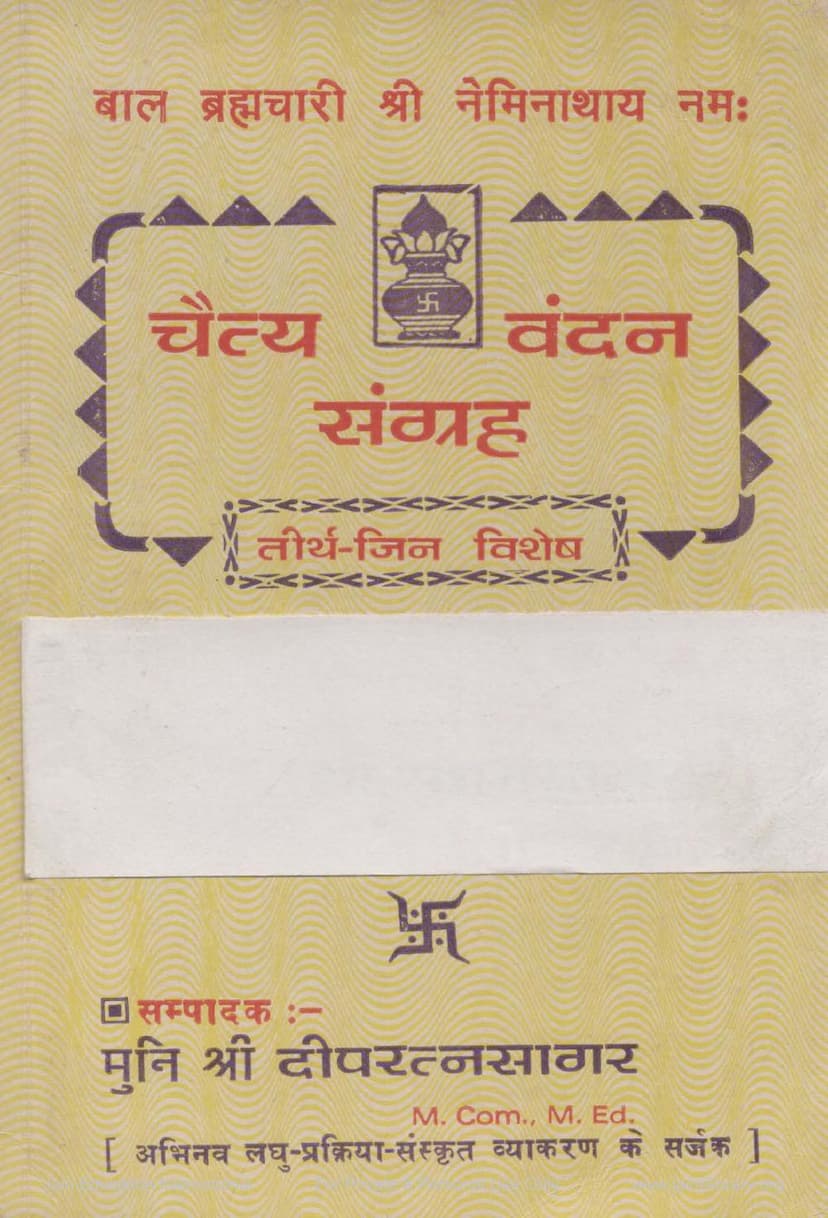Chaityavandan Sangraha Tirth Jin Vishesh
Added to library: September 1, 2025

Summary
This document is the "Chaityavandan Sangraha Tirth Jin Vishesh," a collection of Jain Chaityavandans (devotional hymns or prayers) related to specific pilgrimage sites (Tirths) and Tirthankaras (Jinas). Edited by Muni Shri Deepratnasagar, it aims to provide a comprehensive resource for Jain devotional practices.
Here's a breakdown of its content and purpose:
Purpose and Introduction (Page 2):
- The editor, Muni Shri Deepratnasagar, notes that while collections of stanzas (Stavan, Sajh-jah, Thoyna) exist, a dedicated collection of Chaityavandans was lacking.
- He felt the need to compile Chaityavandans relevant to different occasions and subjects.
- Building upon his previous work ("Abhinav Hem Laghu Prakriya"), he desired to contribute to the devotional (Bhakti Yoga) aspect of Jainism.
- This collection is presented as an essential component for maintaining the purity of one's vision (Darshan Shuddhi).
- The publication aims to contain over 700 Chaityavandans, fulfilling the publisher's name "Abhinav Shrut Prakashan."
- The collection is inspired by the desire to aid those who perform daily worship (Trikal Devavandan), appreciate those observing special days, and support ascetics in their spiritual practices.
- The editor expresses his wish for devotees to experience a flow of devotion from performing these Chaityavandans.
- He prays for the Four-fold Jain Sangha (monks, nuns, male devotees, female devotees) to embrace this effort, which aims to harmonize knowledge and action for attaining pure right faith (Kshayik Samyag Darshan).
Table of Contents (Pages 3-5):
The extensive table of contents reveals the organized structure of the collection, categorizing Chaityavandans by:
- Specific Tirths (Pilgrimage Sites):
- Siddhachalji (including Pundrik Swami, Rayan and Gheti Pagla, Panchtirth, Shatrunjay, Vimalgiri, etc.)
- Samet Shikhar
- Girnarji
- Abu
- Ashtapad
- Various other significant pilgrimage sites.
- Specific Tirthankaras:
- Adinath (Rishabhdev)
- Ajitnath
- Shantinath
- Nemnath
- Parshvanath
- Mahavir Swami
- Aranath
- Mallinath
- Namianth
- Simandhar Swami (a Tirthankara of the Eastern continent)
- Yugandhar Swami (a Tirthankara of the Eastern continent)
- Vihurman Jinas (living Tirthankaras)
- Past and Future Tirthankaras of the current era (Atit Chowvishi, Avanti Chowvishi).
- General Categories:
- Shaashvat and Ashaashvat Tirths (Eternal and Non-eternal pilgrimage sites)
- Chowvish Jinna Naama (Names of the 24 Tirthankaras)
- Chowvish Jinna Ganadharona (Ganadharas of the 24 Tirthankaras)
- Panch Kalyanaka (The five auspicious events in a Tirthankara's life)
- Descriptions, insignia, lifespan, bodily descriptions, measurements, zodiac signs of the 24 Tirthankaras.
- Atishayas (Supernatural powers) of the Arihant Prabhu.
- General descriptions and worship of the Jin.
- Praise of the Panch Parmeshthis (the five supreme beings in Jainism).
- Dushkirt Garharup (repentance for misdeeds).
Content Examples (Pages 5 onwards):
The following pages provide examples of the Chaityavandans themselves. For instance:
- Page 5: Features Chaityavandans dedicated to Shri Siddhachalji, praising its sanctity, the Tirthankara Adinath, and the significance of Pundrik Swami.
- Subsequent pages: Continue to offer various prayers for different Tirths and Tirthankaras, often describing their physical attributes, miracles, and the benefits of worshipping them. The text is primarily in Gujarati, with some Sanskrit verses.
Overall Significance:
"Chaityavandan Sangraha Tirth Jin Vishesh" is a valuable devotional manual for Jains. It aims to:
- Promote devotion: Provide accessible and structured prayers for regular and special occasions.
- Educate: Offer information about various Tirths and Tirthankaras through descriptive hymns.
- Unify practice: Create a single resource for a significant aspect of Jain worship that might have been scattered previously.
- Support spiritual growth: Encourage the practice of Chaityavandan as a means to achieve devotion and ultimately, right faith.